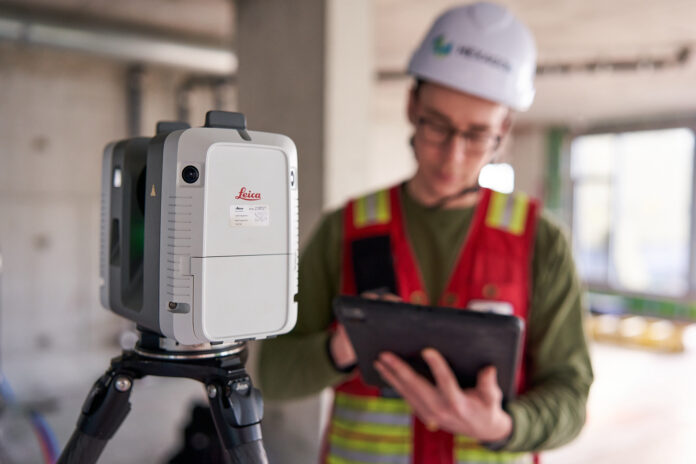The case for adaptive reuse is powerful, ranging from sustainability and cultural preservation to urban regeneration and, of course, business profit.
In the case of real estate development, adaptive reuse is the emerging go-to strategy with estimates now suggesting 90% of all development projects within the next 10 years will involve adaptive reuse. Consider apartment conversions, for example. One report indicates over 58,000 apartments are currently being repurposed from offices; another 4,500 apartments from hotel space in 2023.
To say adaptive reuse is surging may understate the accelerating tempo of owner and investor interest in repurposing, not demolishing. Adaptive reuse is rapidly moving from trend to standard operating procedure as owners seek new ways to revitalize structures that are no longer commercially viable.
Key to this phenomenon is the capability for architects, engineers, general contractors and owners to investigate existing building conditions with certainty and precision. Point cloud data from laser scanning is critical to this vetting process.
“Laser scanning saves so much time in planning and preparation. During construction, you’re not tripping over yourself with change orders bloating your schedule and driving up costs. You solve for clashes before the work begins. The design team has insight into existing conditions with certainty and precision. The model can accurately reflect structural reality down to the millimeter.”
—Adam Cisler
What criteria should building owners use to decide adaptive reuse suitability? One expert asserts that structural integrity, residual service life, spatial layout, location and the ease of installing new building components are key factors.
To help navigate that process and mitigate risk, owners, architects, engineers, consultants and contractors increasingly rely on point cloud data from laser scanning.
“Laser scanning as-built conditions is more than documentation,” explains Adam Cisler, senior solutions engineer for Hexagon, a global leader in sensor and software technologies. “There are many reasons to do a forensic deep dive into a structure. What’s reusable? What requires update and conversion? Today the circular economy drives a big part of the conversation.”
Cisler has ample experience with that vetting process. Throughout his 18-year career, Cisler has investigated repurposing suitability using nearly every tool in the trade, from combing through aging microfiche files at the building inspector’s office and taking time-consuming manual measurements to operating the latest laser scanning hardware and software.
Navigating Projects with No Documentation
Many older properties have little or no documentation available. “I’ve actually taken hand drawn plans and converted them to BIM renderings in order to do clash detection,” Cisler reports. The degree of repurposing can be considerable, such as the time Cisler was part of a team tasked with helping convert a biomedical campus into a corporate headquarters.
What is the condition of the foundation and basement? How about the structural, floor and exterior wall systems? Will they stand up to future live and dead loads? Mechanical, electrical and plumbing (MEP) contractors are particularly wary, Cisler says. That helps explain why 73% of MEP contractors use laser scanners, according to a recent survey, with 42% reporting “very frequent” use in documenting existing conditions.
Enhancing Precision & Insight with Point Clouds
“We’re seeing more and more owners specify laser scanning be done, especially large healthcare companies,” Cisler observes. “Personally, I believe every project should be laser scanned.”
Point cloud data is imperative for many reasons, Cisler says. For the design team, it answers the question ‘Did we miss something?’ by comparing the model with the scan. “Laser scanning saves so much time in planning and preparation. During construction, you’re not tripping over yourself with change orders bloating your schedule and driving up costs. You solve for clashes before the work begins,” he observes. “The design team has insight into existing conditions with certainty and precision. The model can accurately reflect structural reality down to the millimeter.”
Investing in Proven Technology
Given Cisler’s history with adaptive reuse, he is often asked for his opinion on laser scanning technology. What does he recommend?
- “The laser scanner is the reality capture piece, the hardware. You’re looking for a balance of cost, speed, simplicity and point cloud accuracy. You want a solution that delivers point clouds that are dense and rendered fast,” he suggests. “The Leica RTC360 is our benchmark. It checks all the boxes and has been around for several years. That performance may make it more cost-effective than the latest shiny toy on the block.”
- Hardware, of course, is only part of the story. “You need to consider the entire ecosystem that supports the hardware. Software, for example, should simplify and automate registration,” Cisler advises. Registration is the process of combining numerous scans into an integrated, seamless whole.
The software should also mesh point clouds automatically. Automated meshing capabilities should fill in the tiny gaps between individual points, transforming the dataset into a highly detailed virtual environment.
- Another consideration is ease of use. The ecosystem should operate with a low learning curve. “The capture device should be easy to use and require minimal training,” he says, likening the goal to “as easy to use as a smartphone app.”
Cisler is encouraged by the growing role of AI. “Running laser scans through an AI observation will help detect difficult-to-identify structural issues,” he says. Spotting anomalies that might go unnoticed through standard checking procedures means the day is fast approaching when virtually nothing escapes point cloud diagnostics.
In some respects, laser scanning would then become the construction equivalent of an MRI, opening the door to a world of structural insight and risk mitigation scarcely imagined today. That’s welcome news for sustainability and the goal of a circular economy.
To learn more, connect with a Leica Geosystems building construction specialist.






